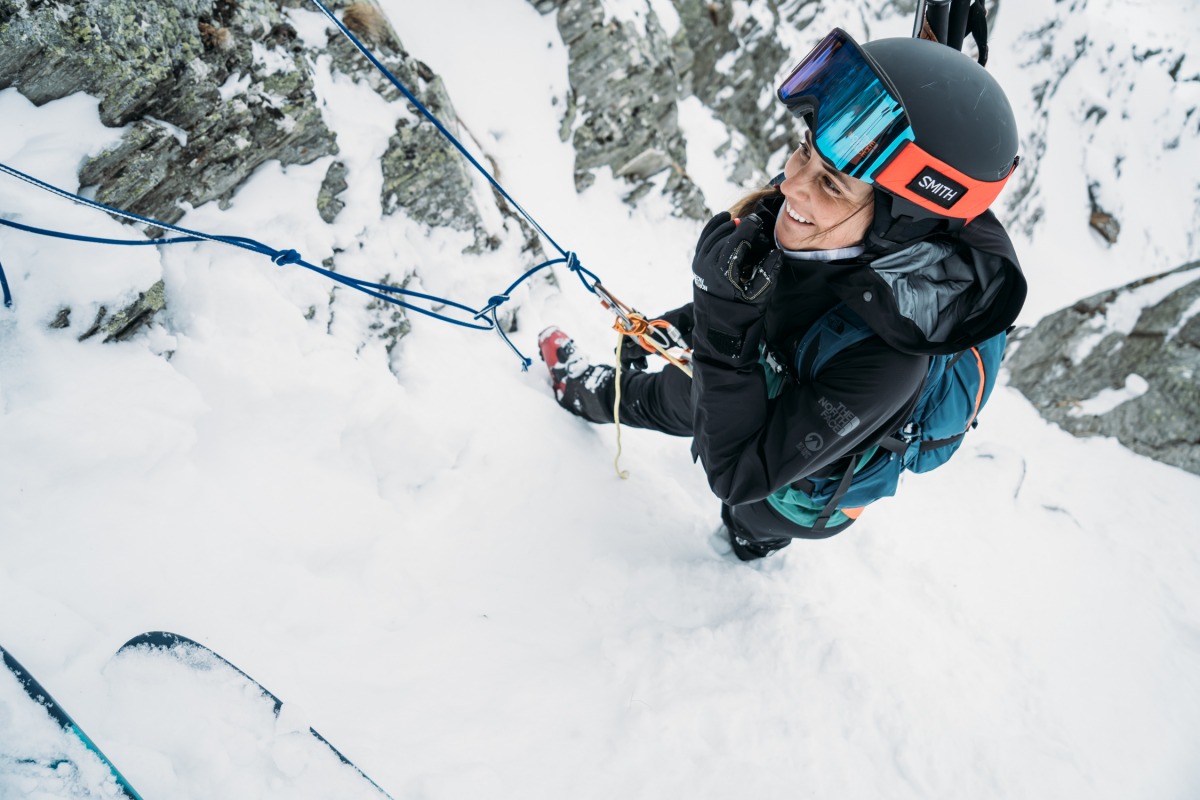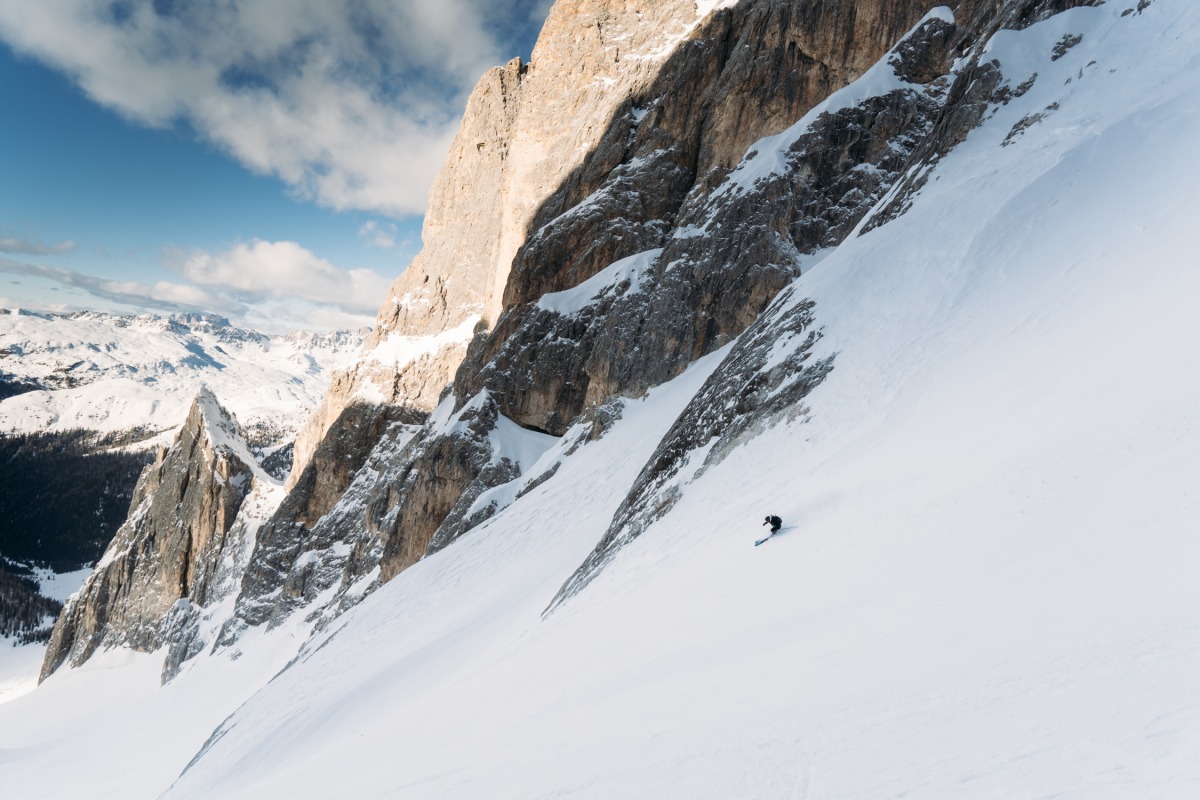
Hadley enjoys ski lines that require a bit of problem solving to get the goods, like this one near her home in Austria. Photo: Leslie Hittmeier
On small boots, backcountry risk and empowering women
Hadley Hammer always seems to be smiling. Whether you spot her goofing in the snow before dropping a huge line or beaming at the camera after nailing the line, her enthusiasm for skiing is both unfailing, and infectious. Since she debuted in the Freeride World Tour at age 25 (‘old’ for most competitors), she’s gone on star regularly in TGR films including Winterland, Far Out and The Rowdiest Female Skiing of 2016.
This success hasn’t necessarily come easily, or without setbacks. A native of Jackson, Wyoming, Hadley ‘warmed the bench’ of most activities growing up. She spent her early twenties pursuing a corporate career in hospitality but the mountains eventually called her back. In 2018 she had a debilitating ski crash that put her in a wheelchair for several months, and a year later suffered the public loss of her boyfriend David Lama to an avalanche.
She now spends her time between Jackson and Innsbruck, Austria, which she praises for its balanced variety of backcountry terrain and the Austrian tradition of afternoon coffee and cake. I called her up to talk about gear, her shifting approach to risk in the mountains and the upcoming backcountry ski season.
WS: How did you get into ski touring?
HH: Ski touring came from gentle exposure while growing up in Jackson where it was a normal activity. Like a kid would go to the mall, you would go on a ski tour somewhere in the Tetons. I remember hiking Teton Pass as early as middle school. Back then you waited until the spring for a solid snowpack to hike Glory Bowl. It’s interesting as a local to see in the heart of winter people charging into such avalanche prone slopes.
WS: Do you remember your first touring setup?
Yeah (laughs), I remember all my touring set ups, as each has been memorable, usually memorably painful. I have a size 5/5.5 shoe size which is a 21 boot. Almost no boot companies address this size or even a common size 6/6.5 in touring boots, so I’ve been left to try everything. I’ve gone from day wreckers (aka Alpine Trekkers) to kids race boots with Fritschi frame bindings. I’ve done 14 hour days in Junior race plug boots that were modified by the CAST guys. It was awesome for the ski down, but even with pins in the toes, the boot doesn’t have anything close to a walk mode. I tried some boots that were called 21 or 22, though my friends whose feet are two sizes larger were wearing the same size as me. This led to a ton of foot pain since I was always contracting in order to keep my foot from moving around in the boot.
I have made a concerted effort to talk to boot companies, selfishly for me but also for all the girls that message me about the same problem. Last year I used Dalbello’s Lupo AX [available in a 21] and it was awesome. Getting at least a few boots in that size is great. And even better is having smaller sizes in the premium offerings as well. I get a lot of messages from guys with small feet that have to use women’s boots and complain that the performance/technology is significantly less than the male versions. I’m hopeful this will change while refusing to accept the standard response that there is not enough demand or the mold is too expensive.
WS: What is your go-to touring set up now?
HH: I’m sponsored by Line so I use the Pandora, their women’s ski, as my touring ski. It’s light and well-balanced. It reacts well to any kind of turn shape you need to make. I’ve started using the Marker Alpinist this year as my touring binding for lighter missions and have been impressed with how that binding works. If I know I’m skiing something really, really technical I’ll take the CAST system. Having a true alpine binding is the safest way to go if the descent is where I’m concerned.
On Backcountry Skiing
WS: You spend a lot of time between the Tetons and Europe. How would you say that backcountry culture differs between the two zones?
HH: I guess I can separate it in a few different ways. In Europe, the landscape and the outdoor spaces for the most part have some evidence of humans. You go into these valleys and even if they’re considered to be some of the more remote valleys there’s usually a hut in them. That’s different than being in the states where I find you actually feel quite remote and technically are quite remote.
That also trickles into safety. In Europe, the rescue systems have much more funding. Getting a helicopter into a valley is easy, whereas in the states that can be difficult to do. When I’m in the states I find I pack my bag with way more layers and a bigger first aid kit knowing my rescue is more dependent on myself.
Also, people really like gear in Europe. Everyone looks so dialed, even if they’re not in technical terms. They all look like pro rando racers out there.
WS: Being from the Tetons, what’s your take on concerns about crowding and safety in the backcountry this season? And have you witnessed the same vibe in Austria?
HH: You can feel it in both places. I’m on the board for Teton County SAR in Jackson so I feel connected to that scene even if I’m not there all season. It’s certainly a topic of concern that’s consistent in our conversations about what this winter will look like.
When you look at the literature of avalanche education and the heuristic traps, I think there’s an additional one now, like a Covid heuristic. The stress levels of any human is high at the moment and I think that’s going to play an interesting role in the backcountry. The backcountry is this escape, but you aren’t always as present as you need to be when you’re trying to escape something. You’re probably thinking about the stress of your job, your family or your health that’s been affected this year. There’s an obvious increase in numbers but also an increase in people with this new stress in their life that we don’t have experience with.
As with all periods of transition there’s always a little bit of chaos and uncertainty. I do think though it will be a cool way for the barriers to entry to be lowered because we’re making resources much more accessible.
On managing risk in the mountains
WS: You’ve spent a lot of time in the mountains and experienced a major injury and personal loss. How would you say your approach to being in the backcountry has shifted over time?
HH: Well, the curtain of control definitely dropped. Quite considerably, especially last year.
Maybe it’s the natural arc that’s usual for anyone that spends time in these outdoor spaces. Before you have any knowledge you have this bold, beginner confidence. Then you take your first avy course and you’re like ‘Oh my God I know nothing and everything is scary’. Then you take two or three more courses and your confidence builds because you have so much more knowledge and experience. But then, your friends or your partners start to die and you almost drop back down to that avy Level 1 fear, like ‘Oh my God I actually have no control whatsoever when I’m out here.’
More than anything, the biggest thing for me is I think less about risk and more about consequences. One thing that bothers me in the outdoor community is that the conversation is so much about risk, which implies we have more control than I think we do.
What I would hope that the conversation shifts more to is consequence, being like, ok you are choosing to go into the backcountry and to ski at a resort. How are you setting your life up so that if something does go wrong, the effects are minimized? Do you have even basic things like your passwords to your life all in one place that can be accessed? Do the people around you know that you love them and care for them? If you were to die or get injured what effects would that have on yourself or the people around you and what can you do to set that course to be smoother?
On social media and responsibility
WS: As a sponsored athlete, you’re pretty visible on social media. Do you think that athletes in your position have a certain responsibility to the actions they put on display?
HH: It’s absolutely my responsibility to believe that my audience is going to take everything I say literally. And my audience includes young girls and boys. That’s something I try to keep in mind when I’m posting. I’m rebuilding my website so I can go into depth on my thoughts on the backcountry, or on an experience or missed call that I had and then people can really get the full story. The dangerous part about Instagram especially is you’re not getting the full story of what’s happening.
On increasing inclusivity in ski touring
WS: What advice do you have for young women getting into ski touring? How do you think ski touring can be more inclusive to more kinds of people?
HH: If anything, my goal with my career is to show that the limitations we place on ourselves are created in our own minds. They can also be changed in our own minds. It’s a little cheesy but if you see yourself out there, go out there. Hard work will go a long way.
Especially for girls, there’s a lot of power in being independently strong, both in your physical sense and also your knowledge of the backcountry. I think women have a special gift, especially in touring and the backcountry to quietly suffer for a long time, but also because we tend to be more empathetic and a little more sensitive, it means we can be more sensitive to group dynamics and more changes in the environment which then clues you into safety. I don’t want to be a boy. In the past few years I’ve begun to embrace that I’m a woman and that those traits can be an advantage in the backcountry. The softer, quieter, more sensitive can actually keep you alive for much longer.
Keep tabs on what Hadley’s skiing, reading and thinking at hadleyhammer.com. Of course, you can find her on Instagram also, @hadhammer
Manasseh Franklin is a writer, editor and big fan of walking uphill. She has an MFA in creative nonfiction and environment and natural resources from the University of Wyoming and especially enjoys writing about glaciers. Find her other work in Alpinist, Adventure Journal, Rock and Ice, Aspen Sojourner, AFAR, Trail Runner and Western Confluence.

